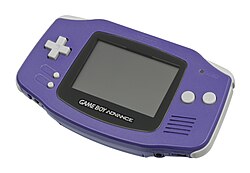Game Boy Advance
(Redirected from Gameboy Advance)
The Game Boy Advance, commonly abbreviated as GBA, is a 32-bit handheld video game console. It was manufactured by Nintendo. The predecessor to the Game Boy Advance was the Game Boy Color. The Game Boy Advance was eventually succeeded by the Nintendo DS in 2004.
 The indigo version of the original Game Boy Advance | |
| Developer | Nintendo R&E |
|---|---|
| Manufacturer | Nintendo |
| Product family | Game Boy line |
| Type | Handheld game console |
| Generation | Sixth generation |
| Release date | Game Boy Advance: March 21, 2001[1] BRAAUS June 20, 2001June 22, 2001[2] INDGame Boy Advance SP: AGS-001: February 14, 2003 CANAUS April 10, 2003CHN December 1, 2003KOR January 18, 2004AGS-101:CHN 2003September 19, 2005 NAGame Boy Micro: September 13, 2005 NAAUS November 3, 2005November 4, 2005 KOR |
| Retail availability | 2001–2008[3] |
| Discontinued | 2008 NAAUS May 16, 20092009 KORHK 20092009 EU |
| Units sold | 81.51 million (as of June 30, 2010[update])[3] |
| Media | ROM cartridge |
| Power | 2 × AA batteries |
| CPU | ARM7TDMI @ 16.78 MHz, Zilog Z80 @ 8 or 4 MHz |
| Memory | 32 KB internal, 256 KB external, 96 KB VRAM |
| Display | TFT LCD, 240×160 pixels, 40.8×61.2 mm[4] |
| Best-selling game | Pokémon Ruby and Sapphire, 16 million combined[5] |
| Backward compatibility | Game Boy, Game Boy Color (GBA and GBA SP only) |
| Predecessor | Game Boy Color (1998)[6] |
| Successor | Nintendo DS (2004) |
The Game Boy Advance was released in Japan on March 21, 2001. Nintendo later released it in North America on June 11, 2001, in Australia on June 20, 2001, and in Europe on June 22, 2001.
Best-sold games
Top 25 best-sold games on Game Boy Advance (sold numbers in brackets):
- 1. Pokémon Ruby and Sapphire (16.2 million)
- 2. Pokémon FireRed and LeafGreen (12 million)
- 3. Pokémon Emerald (7.06 million)
- 4. Mario Kart: Super Circuit (5.91 million)
- 5. Super Mario World: Super Mario Advance 2 (5.69 million)
- 6. Super Mario Advance (5.57 million)
- 7. Super Mario Advance 4: Super Mario Bros. 3 (5.43 million)
- 8. Namco Museum (2.96 million)
- 9. Pac-Man Collection (2.94 million)
- 10. Yoshi's Island: Super Mario Advance 3 (2.83 million)
- 11. The Legend of Zelda: A Link to the Past (2.82 million)
- 12. Pokémon Mystery Dungeon: Red Rescue Team (2.36 million)
- 13. NES Classics Series: Super Mario Bros. (2.27 million)
- 14. Wario Land 4 (2.2 million)
- 15. Mario & Luigi: Superstar Saga (2.15 million)
- 16. Kirby: Nightmare in Dream Land (2.1 million)
- 17. Finding Nemo (1.84 million)
- 18. Donkey Kong Country (1.82 million)
- 19. The Legend of Zelda: The Minish Cap (1.76 million)
- 20. Yu-Gi-Oh! The Eternal Duelist Soul (1.71 million)
- 21. Golden Sun (1.65 million)
- 22. Final Fantasy Tactics Advance (1.62 million)
- 23. Metroid Fusion (1.6 million)
- 24. Kingdom Hearts: Chain of Memories (1.54 million)
- 25. Sonic Advance (1.51 million)
Game Boy Advance Media
Game Boy Player under a GameCube
References
- ↑ "Game Boy Advance: It's Finally Unveiled". IGN. August 23, 2000. Retrieved July 19, 2014.
- ↑ Bramwell, Tom (March 21, 2001). "GBA Day: June 22nd". Eurogamer. Retrieved July 19, 2014.
- ↑ 3.0 3.1 "Consolidated Sales Transition by Region" (PDF). Nintendo. Archived from the original (PDF) on May 1, 2016. Retrieved November 18, 2016.
- ↑ "Technical data". Nintendo of Europe GmbH.
- ↑ Rose, Mike (October 15, 2013). "Pokemon X & Y sell 4M copies in first weekend". Gamasutra. Think Services. Retrieved July 19, 2014.
- ↑ Umezu, Sugino & Konno. Interview: Transcript with Satoru Iwata. Nintendo 3DS (Volume 3 – Nintendo 3DS Hardware Concept). Assessed on March 7, 2011.






